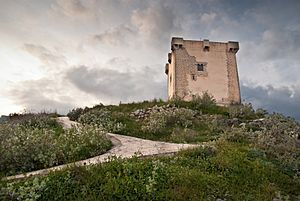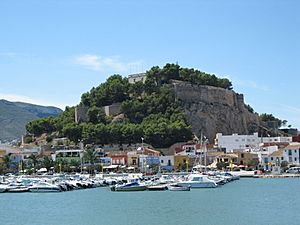Route of the Valencian classics facts for kids
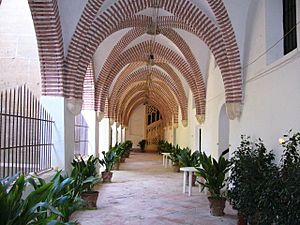
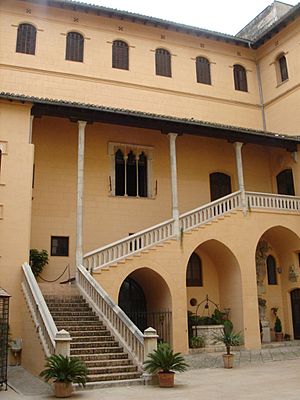
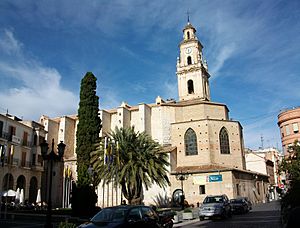
The Route of the Valencian Classics is a special journey through the lands of some of the most famous writers from the Valencian Community. These writers lived during a time called the Valencian Golden Age in the 15th century. The three main writers on this route are Ausiàs March, Joanot Martorell, and Joan Roís de Corella. They were all connected to the court of Duke Alfonso of Aragon and Foix, who was known as "the Old."
This route helps you imagine what life was like in Valencia during the 1400s. You'll explore old buildings, beautiful landscapes, and learn about the local food and language. It's a chance to hear the echoes of the amazing words written by these important Valencian authors.
Contents
What You'll See on the Route
This exciting route takes you to many interesting places and historical buildings:
- Gandía
- Beniarjó
- Manor house of Ausias March
- Alfauir
- Albaida
- Cocentaina
- Xaló
- Manor house of Joanot Martorell
- Route of the Martorell
- Dénia
- Castle of Denia
Exploring the Route Step by Step
Let's discover each stop on the Route of the Valencian Classics!
Gandia: A City of Writers
Gandía was a very important city for writers in the 15th century. Families like the Martorell, March, and Roís de Corella lived here.
- Collegiate Basilica of Gandia: This church is a great example of Valencian Gothic architecture. It reminds us of the classic writers and also the powerful House of Borgia family. The Borgias made Gandia a very strong duchy in 1485.
- Ducal Palace of Gandia: In this grand palace, the Valencian classic writers learned about literature and the art of chivalry. Chivalry was the code of conduct for knights.
- Convent of Santa Clara: The beautiful art inside this convent shows how rich and important the Duchy of Gandia once was. Old walls from the 1300s near the Serpis river still stand, showing parts of the medieval city.
- Sant Marc Hospital: Today, this building is an archaeological museum. Its Gothic arches take you back to the Middle Ages.
Beniarjó: Home of a Poet
- Manor house of Ausias March: This was the home of the famous poet Ausiàs March.
Alfauir: A Peaceful Monastery
- Monastery of Sant Jeroni de Cotalba: This historic monastery holds the tombs of Pere March (Ausiàs March's father) and Ausiàs March's two wives. It is one of the oldest and most important monasteries in the Valencian Community.
Albaida: History and Art
Albaida offers a mix of history and art.
- Parish Church of the Asunción: This church was first built in the 1200s. The current building was constructed between 1592 and 1621 in the Valencian Gothic style. You can see interesting oil paintings by Josep Segrelles here.
- Palace of Milà i Aragó: Parts of the 15th-century walls still remain, showing the palace's long history. Inside this palace today, you'll find the International Museum of Puppets of Albaida (MITA).
- Segrelles Museum: This museum is the house where the Valencian painter Josep Segrelles lived.
Cocentaina: Castles and Mountains
Cocentaina is known for its impressive castle and medieval quarter.
- Palace of the Counts of Cocentaina: This palace belonged to the Roís de Corella family in the 15th century. You can also see old towers and parts of the town's medieval wall here.
- Cocentaina Castle: The castle stands high above the whole region. In these mountains, you might find "fridges" or snow deposits. These were used long ago to store ice for trade.
Xaló Valley: A Land of Mountains
To reach the sea, you must travel through the mountain valleys of the Marina Alta. These include Planes, La Vall de Gallinera, La Vall d'Alcalà, and La Vall d'Ebo. This was where Al-Azraq, a Muslim leader, fought against the Aragonese conquest in the 1200s. This history is the origin of the famous Moors and Christians festival. The valley of Xaló was once owned by the Martorell and March families.
- Manor house of the Martorell: In Xaló, you can find this manor house that belonged to the writer Joanot Martorell. It was updated in the 1800s.
- Route of the Martorell: This part of the route explores more about Joanot Martorell's life and connections to the area.
Dénia: A Coastal Fortress
Alfonso of Aragon and Foix was also the Count of Denia. The city was managed by an attorney general, who was Ausiàs March's father, Pere March.
- Castle of Denia: On the walls of this castle, someone who lived at the same time as Ausiàs March drew graffiti of ships in the harbor. This shows the sea landscape that March knew and that is mentioned in the famous book Tirant lo Blanch by Joanot Martorell. When you visit Dénia, make sure to see the Raset quarter, the Rotes coves, and the foot of Montgo mountain.
See also
 In Spanish: Ruta de los clásicos valencianos para niños
In Spanish: Ruta de los clásicos valencianos para niños


